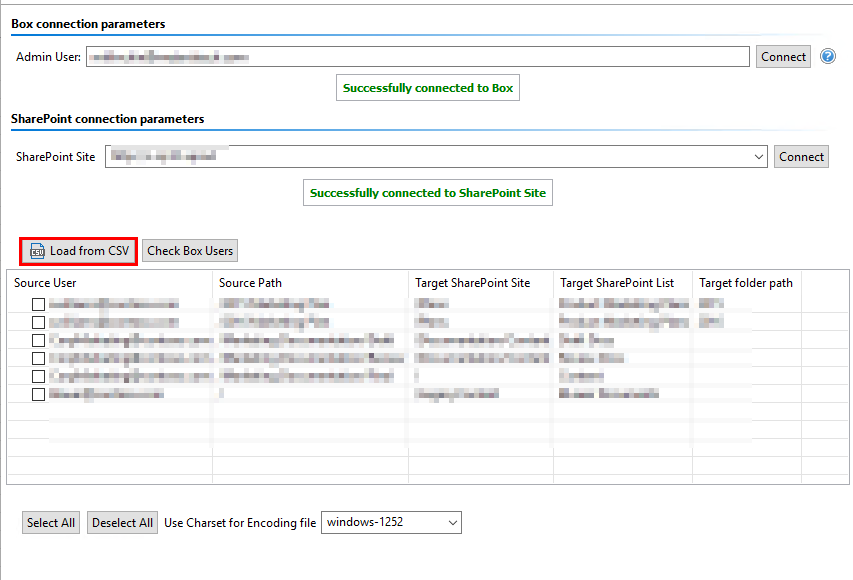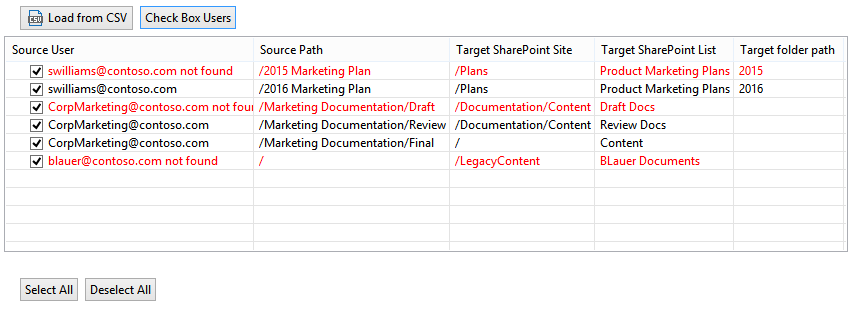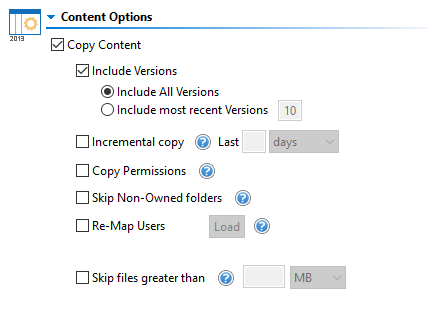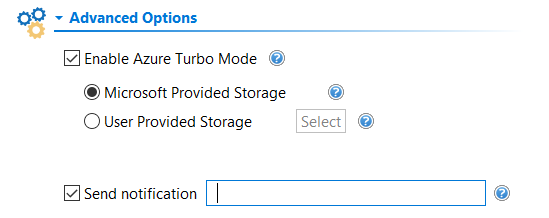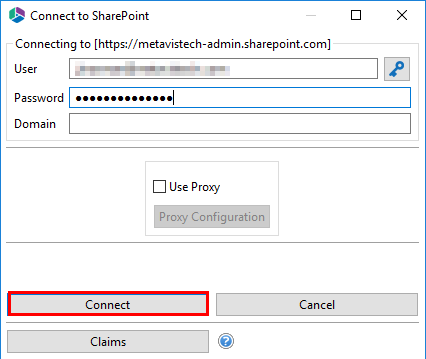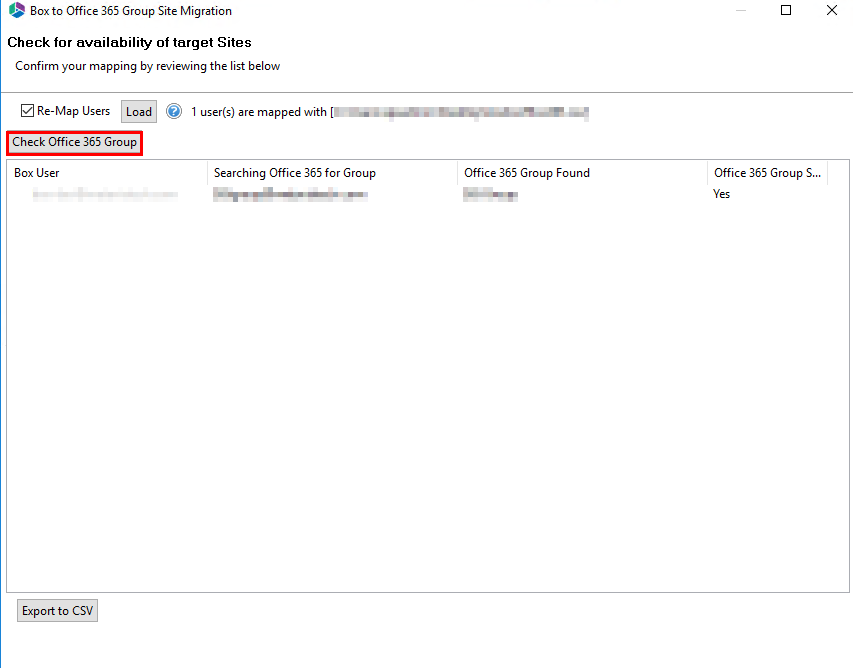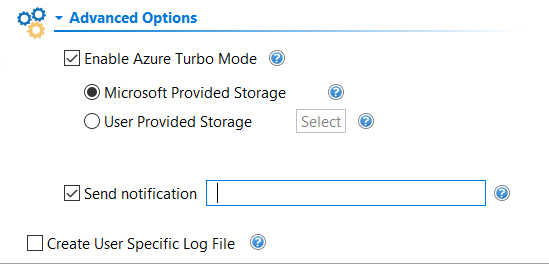Box- Unsupported Objects
The following Box objects are not supported when migrating to OneDrive for Business or SharePoint Online.
·Box Notes
·Box Bookmarks
·Comments
·Custom Terms of Service
oIf the Box tenant has a Custom Terms of Service configured and a user has not Accepted the Terms of Service, then their Box account cannot be accessed and therefore their content cannot be migrated.
·External users (permissions and metadata)
·File and Folder descriptions
·Google Documents
·Google Spreadsheets
·Objects in the "Trash"
·Office documents created in Box with a size of 0 KB cannot be migrated using Azure Turbo
·"Tags" and Favorite labels
oThe item can still be migrated, however these labels will not be retained.
·Version history when a more recent version has a created date earlier than a previous version cannot be migrated using Azure Turbo.
·Mass migration from Box to Office 365 preserves file information available in the Version history section only, the original information from file shares gathered in the File Information section is not supported during migration.
Copy Box to SharePoint Online
This option allows Box and Office 365 administrators to migrate folders (and their subfolders and files) from within multiple Box Drives to one or more document libraries in a SharePoint Online Site Collection.
|
|
NOTE: If you attempt to connect or open a Box drive through the software and it does not respond, please review the section Alternate Framework. |
This operation has the following requirements for use:
·The account used to perform the migration from Box needs to have Full Admin access to the Box tenant.
·The account used to perform the migration into SharePoint Online needs to have at minimuim Designer permissions to the destination Site Collection. Full Control or Site Collection Administrator are recommended to avoid potential permission related issues during migration.
·The person performing the migration will need to know the relationship between each user's Box user account and their corresponding Office 365 user account. Please see the User Mapping section for an overview on how to create a CSV User Mapping file.
·The destination sites and libraries must exist in SharePoint Online prior to migration.
Once the requirements above are satisfied, you can proceed with your Box to SharePoint Online migration.
1.On the Drives tab, Click the Copy Box button, and select "Copy Box to SharePoint".
2.Give your project a name.
3.Enter the username of your Box Administrator and click Connect.
4.When the Connect to Box popup appears. enter the Admin account's password and click Connect. If your Box authentication requires additional security steps (i.e. single sign-on) then click the "Claims" button and enter your Box Admin and Password credentials into the browser popup to continue.
|
|
NOTE: If you attempt to connect or open a Box drive through the software and it does not respond, you may require an alternate framework. Please review the section Alternate Framework for instructions on how to install the alternate framework. |
5.In the SharePoint Connection Parameters section, specify the destination SharePoint Online site URL and then click Connect. When prompted, enter your Office 365 user login and password and then click Connect. If you receive any message other than successfully connected, double check the URL and make sure you are supplying a user login with sufficient permissions for this site. If you are still experiencing issues, please contact Support for further assistance.
|
|
NOTE: when connecting to a SharePoint Online Site in this step, please be aware that you may migrate content into any library within this site or any sub-site beneath it. If you want to migrate content to a different site collection, then you will need to configure a second migration. |
6.Your next step is to click the Load from CSV button. This option is required in order to map which folders from Box are migrated into which specific document library in your SharePoint Online site(s).
The CSV format includes the following 5 headers and is specific to a single target SharePoint Online root location as defined in the SharePoint Site field.
1.Source User - This column defines the source Box user account which contains the folder that should be migrated. Your CSV file may contain one or more source Box user accounts.
2.Source Path - This column defines the path to the root folder (including all its child content) from Box that you wish to migrate. If you want to migrate all folders and root content from a Box user, simply enter a forward slash (/) in this column. Your CSV file may contain one or more source folder paths for each source Box user.
3.Target SharePoint Site - This column defines the site or sub-site you wish to use as your destination location. If you want to migrate to the root site as defined in the SharePoint Site URL, then simply enter a forward slash (/) in this column. If you wish to migrate to a sub-site of the root, then enter the relative path to your sub-site starting at the root level (i.e. /subsite1/subsite2). Please note that each defined target site or sub-site must already exist in SharePoint Online as this process will not create this new site. This will then result in an error during migration.
4.Target SharePoint List - Target SharePoint List - This column defines the document library you wish to use as your destination list. Please enter the library's Internal Name into this column. Please note that each defined target library must already exist in SharePoint Online as this process will not create this new library, if you do not do this, it will result in an error during migration.
5.Target folder path - This column defines the folder that you would like to use as your destination location. If you want to migrate to the root of the library defined in the Target SharePoint List column, then simply enter a forward slash (/) in this column. If you wish to migrate to a sub-folder of the root, then enter the relative path to your sub-folder starting at the root level (i.e. /folder1/folder2).
For an example CSV file downloaded from here. Please do not modify the first row (headers) of the CSV file, but do modify the remaining values starting in the second row to meet your needs.
7.Click the Check Box Users button in order to verify that the source users, as defined in the loaded CSV file, are found within your Box tenant. After the function is complete, all source users not found will be displayed in red font while users successfully located will remain in the default black font. This acts as a warning that you may have entered an invalid user or there is an issue locating the defined user(s). You may still proceed with the migration, however you should expect errors when trying to migrate from these users.
|
|
NOTE: Check Box Users only verifies if the source Box user account was located. It does not validate the existence or accuracy of any other value in the CSV file, so please be sure to visually confirm before proceeding. |
8.Select the Box drives that you wish to include with this migration, or select the Load and Apply Report button, which allows you to load and apply an Analyze Box report, which then sets the Migration Priority for each user mentioned in the report. Click Next to continue.
|
|
NOTE: Each Migration Priority value can be changed if you click on the value in the Migration Priority columns (without user selection). It changes the migration queue but does not change the original report file. Priority in the wizard is not saved after the wizard has been closed. |
9.The final page provides a few options to configure how the content portion of the operation should be configured.
Content Options:
Copy Content - A flag to determine if content is or is not included with this operation. When not included the remainder of the options will become disabled.
Include Versions - The process in which Box version history will be converted into SharePoint Online. You can specify whether All Versions or the specified most recent versions are included.
Incremental Copy - When enabled, the migration process will identify and migrate only that content which was created, modified or versioned within the defined interval (days, weeks or months).
Copy Permissions - Will convert Box folder permissions (known as Collaborators) into SharePoint Online folder permissions.
Skip Non-Owned Folders - This option addresses the scenario where folders appear in a user's Box account which are not owned by this user; meaning the user is a folder collaborator and not the folder "Owner". Skipping these folders will prevent duplicates from being migrated into SharePoint Online because the folder will be migrated only once when the folder "Owner" is migrated. Please refer to the in-application Help button for additional details.
Re-Map Users - Will allow both permissions (if included) and user metadata like Created and Modified By to be properly mapped from Box to Office 365. Please refer to the following page for additional information: User Mapping. Please note that this mapping file can also contain Box Groups to SharePoint Groups or federated Active Directory groups in Office 365. Please refer to the following page for additional information: Box - Group Mapping
Skip Files Greater Than - When enabled, this option will skip any source files that are greater than the value specified (in MB or GB). An entry will be added to the post-migration log indicating which file(s) were skipped due to this configuration.
Advanced:
Enable Azure Turbo Mode: When enabled, this option utilizes Microsoft's SharePoint Online Migration API to increase the migration performance and throughput. A recommendation for optimal use of this API is larger sets of data; the more content, the better the throughput. Please review the User Manual for additional information as well as recommended configuration as this process is a resource intensive operation.
Because this API uses Azure storage as a staging area for the migration, it requires that you provide an Azure storage location. The options are to either utilize Microsoft supplied storage or to provide your own Azure storage location. If you wish to use your own Azure account, you must provide both the Azure Account Name as well as the corresponding Acces Key. If you cannot supply this information, please search our online Knowledge Base, User Manual or contact Support for additional information before proceeding or consider using the Microsoft Supplied Storage option. For more information please see the Azure Turbo Mode section.
|
|
NOTE: this function is optional and is only used to increase the migration performance to SharePoint Online or OneDrive for Business in Office 365. It does not provide any additional functionality that is not available when this option is disabled. |
·Microsoft Provided Storage: This option allows you to use Microsoft provided Azure storage instead of providing your own for the purpose of utilizing Azure Turbo Mode.
·User Provided Storage: This option allows you to provide your own Azure Storage instead of using one provided by Microsoft for the purpose of utilizing Azure Turbo Mode. It requires that you provide both your Azure Blob Storage Account Name as well as its corresponding Access Key by clicking the "Select" button to the right. If you cannot supply this information, please search our online Knowledge Base, User Manual or contact Support for additional information before proceeding.
|
|
NOTE: User Provided storage will give you access to Azure logs for a longer period of time than Microsoft provided storage. It will also allow you to perform the migration faster with less throttling. |
Send Notification: When selected, this feature will send emails to the listed recipients once Migrations are completed. Enter a specific user email address. For two or more, separate each email address with a comma. Set up User Notifications here in order to use this feature.
10. Click Finish to begin the migration.
Box- Unsupported Objects
The following Box objects are not supported when migrating to OneDrive for Business or SharePoint Online.
·Box Notes
·Box Bookmarks
·Comments
·Custom Terms of Service
oIf the Box tenant has a Custom Terms of Service configured and a user has not Accepted the Terms of Service, then their Box account cannot be accessed and therefore their content cannot be migrated.
·External users (permissions and metadata)
·File and Folder descriptions
·Google Documents
·Google Spreadsheets
·Objects in the "Trash"
·Office documents created in Box with a size of 0 KB cannot be migrated using Azure Turbo
·"Tags" and Favorite labels
oThe item can still be migrated, however these labels will not be retained.
·Version history when a more recent version has a created date earlier than a previous version cannot be migrated using Azure Turbo.
·Mass migration from Box to Office 365 preserves file information available in the Version history section only, the original information from file shares gathered in the File Information section is not supported during migration.
Copy Box to an Office 365 Group
This option allows administrators to move content from multiple Box Accounts to Office 365 Group Sites default (Documents) library in a single operation.
|
|
NOTES: If you attempt to connect or open a Box drive through the software and it does not respond, please review the section Alternate Framework. |
This operation has the following requirements for use:
·The account used to perform the migration from Box needs to have Full Enterprise Admin access to the Box tenant.
·The account used to perform the migration into an Office 365 Group Site needs to be a minimum of Site Collection Administrator in this Office 365 tenant.
·The person performing the migration will need to know the relationship (user mapping) between each user's Box user account and their corresponding Office 365 Group name and Office 365 user account.
·The Office 365 Group and its Site must already exist.
Once the requirements above are satisfied, you can proceed with your Box to Office 365 Group Site migration.
1.On the Drives tab, Click the Copy Box button, and select "Copy Box to Office 365 Groups".
2.Select a Profile and give your project a name.
3.Enter the username of your Box Administrator and click Connect.
4.When the Connect to Box popup appears, enter the Admin account's password and click Connect. You will return back to the migration configuration where a "Successfully connected to Box" message will appear.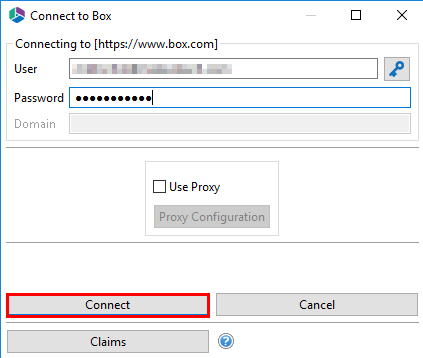
|
|
NOTE: If you attempt to connect or open a Box drive through the software and it does not respond, you may require an alternate framework. Please review the section Alternate Framework for instructions on how to install the alternate framework. |
5.In the Target Office 365 Connection Parameter section, enter your tenant SharePoint Administration Center URL, and then click Connect (i.e. https://tenant-admin.sharepoint.com).
6.When prompted, enter your Administrator login and password. Click Connect. If you receive any message other than "Successfully connected to SharePoint Admin", double check the URL and make sure you are supplying a Global Administrator login for this tenant. If you are still experiencing issues, please contact Support for further assistance.
7.Click the Load from Box button to load in a list of available Box drives to include with this migration. For performance reasons, if you have a large number of Box drives in your tenant you may wish to create a single column CSV file with the user accounts and choose the option Load from CSV instead.
8.Select the Box drives that you wish to include with this migration, or select the Load and Apply Report button, which allows you to load and apply an Analyze Box report, which then sets the Migration Priority for each user mentioned in the report. Click Next to continue.
|
|
NOTE: Each Migration Priority value can be changed if you click on the value in the Migration Priority columns (without user selection). It changes the migration queue but does not change the original report file. Priority in the wizard is not saved after the wizard has been closed. |
9.Select Re-Map Users option and load your mapping CSV file. Group mapping is required (user mapping may also be included) so the software can properly resolve the differences between your users' Box account and the corresponding Office 365 Group name as well as maintain content authorship. If your user accounts differ between Box and Office 365 then you will want to add your user mapping to this same file.
In the example below, lines 1-3 illustrate mapping a source Box to an Office 365 Group by name while lines 4-5 in the same file are used to map the Box user accounts to their respective Office 365 user accounts to maintain item authorship.
sales@company.com,Office365 Group Name
marketing@company.com,Office365 MarketingGroup
IT@company.com,IT Group
scott@company.com,swilson@contoso.com
bill@company.com,bgeorge@contoso.com
If you wish to migrate one or more source accounts to a single Group library while also remapping the user account for the purpose of metadata and sharing, please use the following format in your mapping file.
user@box.com,Office 365 GroupName(user@contoso.com
The software will migrate the content from the source drive "user@box.com" to the Documents libary in the group "Office 365 GroupName". The metadata and shared permissions of Box user "user@box.com" will be mapped to the Office 365 user account "user@contoso.com".
10.Click Check Office 365 Groups in order to begin the validation process. This process will validate that the supplied user mapping is correct (Office 365 Groups were located) and check to determine if each Group currently has a Site provisioned. Click Next.
|
|
NOTE: If the Group does not exist on the target it will be created using the migration administrator as the owner. |
11.The final page provides a few options to configure how the content portion of the operation should be configured.
Content Options:
Copy Content - A flag to determine if content is or is not included with this operation. When not included the remainder of the options will become disabled.
Include Versions - The process in which Box version history will be converted into Office 365 Group Site versions. You can specify whether All Versions or the specified most recent versions are included.
Incremental Copy - When enabled, the migration process will identify and migrate only that content which was created, modified or versioned within the defined interval (days, weeks or months).
Skipped Non-Owned Folders - This option addresses the scenario where folders appear in a user's Box account which are not owned by this user; meaning the user is a folder collaborator and not the folder "Owner". Skipping these folders will prevent duplicates from being migrated into Office 365 Group because the folder will be migrated only once when the folder "Owner" is migrated. Please refer to the in-application Help button for additional details.
Skip files greater than - This provides the functionality to skip all files larger than the value specified. Unit of measure is configured for MB or GB.
Migrate to Folder - When this option is enabled, you can create a (or use an existing) root folder structure in the destination library where your source content will be migrated. You will need to define the path like this example:
/My Source Content/2017
In the above example, the folder "My Source Content" and subfolder "2017" will be created in the root library of your destination and all source content will be migrated to this folder location.
Advanced Options:
Enable Azure Turbo Mode: When enabled, this option utilizes Microsoft's SharePoint Online Migration API to increase the migration performance and throughput. A recommendation for optimal use of this API is larger sets of data; the more content, the better the throughput. Please review the User Manual for additional information as well as recommended configuration as this process is a resource intensive operation.
Because this API uses Azure storage as a staging area for the migration, it requires that you provide an Azure storage location. The options are to either utilize Microsoft supplied storage or to provide your own Azure storage location. If you wish to use your own Azure account, you must provide both the Azure Account Name as well as the corresponding Acces Key. If you cannot supply this information, please search our online Knowledge Base, User Manual or contact Support for additional information before proceeding or consider using the Microsoft Supplied Storage option. For more information please see the Azure Turbo Mode section.
|
|
NOTE: this function is optional and is only used to increase the migration performance to SharePoint Online or OneDrive for Business in Office 365. It does not provide any additional functionality that is not available when this option is disabled. |
·Microsoft Provided Storage: This option allows you to use Microsoft provided Azure storage instead of providing your own for the purpose of utilizing Azure Turbo Mode.
·User Provided Storage: This option allows you to provide your own Azure Storage instead of using one provided by Microsoft for the purpose of utilizing Azure Turbo Mode. It requires that you provide both your Azure Blob Storage Account Name as well as its corresponding Access Key by clicking the "Select" button to the right. If you cannot supply this information, please search our online Knowledge Base, User Manual or contact Support for additional information before proceeding.
|
|
NOTE: User Provided storage will give you access to Azure logs for a longer period of time than Microsoft provided storage. It will also allow you to perform the migration faster with less throttling. |
Send Notification: When selected, this feature will send emails to the listed recipients once Migrations are completed. Enter a specific user email address. For two or more, separate each email address with a comma. Set up User Notifications here in order to use this feature.
Create User Specific Log File - If you would like a user specific log file (.txt format) created for each migrated Google Drive, that will be saved directly to that Group's Documents library, check this option before you finish. This log file will contain all the content that was included in the migration with both source and target URLs as well as any file renaming that took place and skipped files due to lack of ownership.
NOTE: Create user Specific log file is disabled if Azure Turbo Asynchronous mode is on. Supported only for CSOM or Azure Turbo Synchronous modes.
|
|
NOTE: Content permissions are not migrated because Office 365 Group permissions are maintained and enforced by the group membership and its roles (Owners, Members and Guests). |
12. Click Finish to begin the migration.





